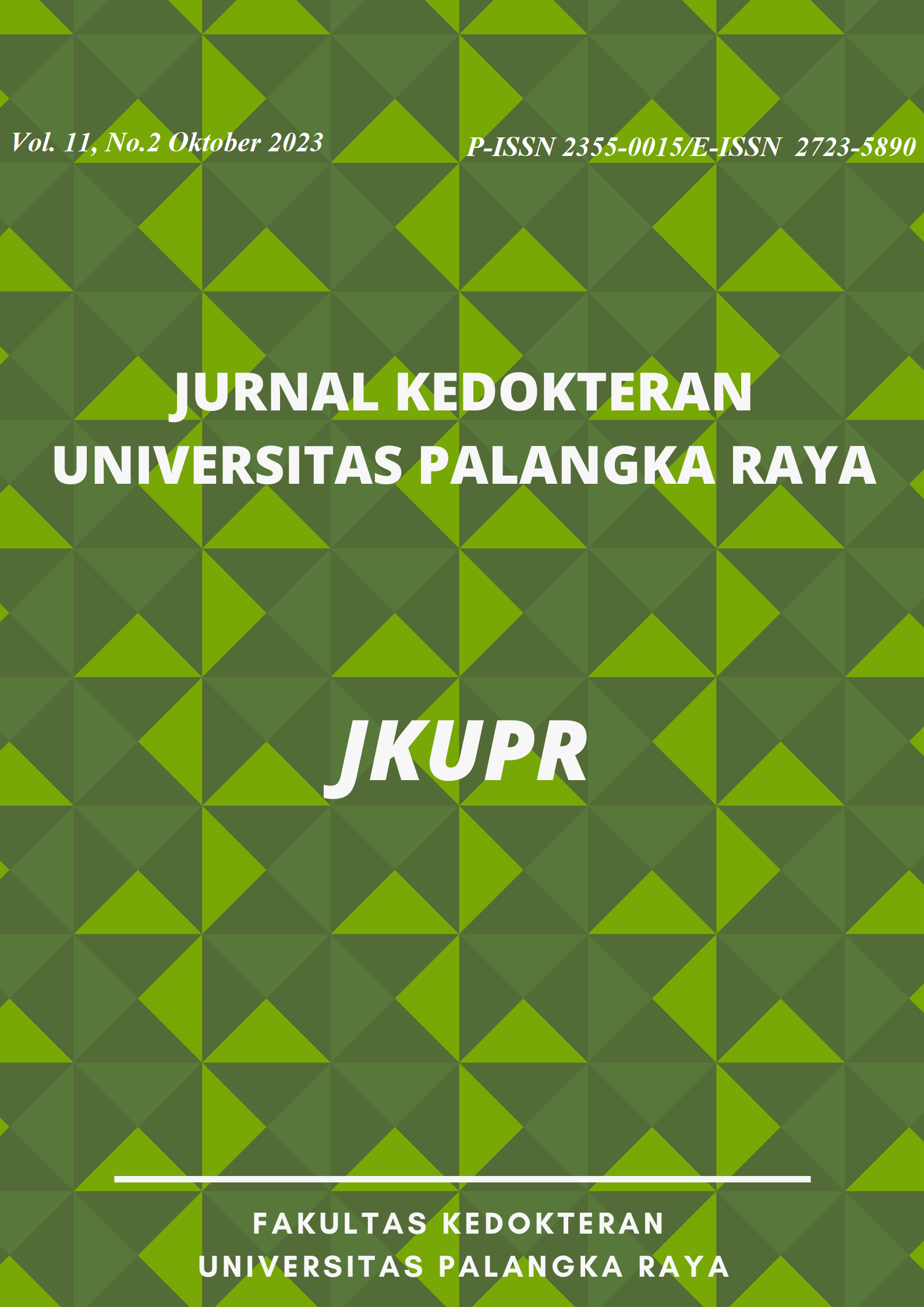Uji aktivitas antimikroba ekstrak daun tumbuhan akar kucing (Acalypha indica l.) terhadap mikroba patogen manusia
DOI:
https://doi.org/10.37304/jkupr.v11i2.11040Kata Kunci:
Acalypha indica L., antimicrobial, and zone of inhibitionAbstrak
The leaves of Acalypha indica L. were used as the object that are easily found around the home contain secondary metabolites as antimicrobials for Meticillin Resistant Staphylococcus aureus (MRSA) and Candida albicans. The method used for plant sampling is purposive sampling method. Extraction of active compounds using maceration method. The antimicrobial potency test used the agar-diffusion method using two types of microbial pathogens: Meticillin Resistant Staphylococcus aureus (MRSA) and C. albicans. Each paper disk was given 50 L of bacterial isolate and incubated at 370 C for 24 hours and continued for 48 hours. The parameter observed is the clear zone formed around the paper disk. The results showed that the leaves of contained compounds that could inhibit the growth of MRSA bacteria and the fungus. A good solvent to extract the active compounds contained in the leaves of is distilled water. The extract - distilled water treatment with a concentration of 100% had the widest inhibition zone among other treatments, which was 4.5 mm against the growth of the fungus
Unduhan
Referensi
Adnan, Navia ZI, Silvia M, Antika M, Suwardi AB, Baihaqi, et al. Diversity of herbs and spices plants and their importance in traditional medicine in the South Aceh District, Indonesia. Biodiversitas. 2022;23(7):3836–43. Doi: 10.13057/biodiv/d230761.
Chattu VK, Singh B, Pattanshetty S, Reddy S. Access to medicines through global health diplomacy. Heal Promot Perspect [Internet]. 2023;13(1):40–6. Available from: https://doi.org/10.34172/hpp.2023.05. Doi: 10.34172/ hpp.2023.05.
Salehi B, Iriti M, Vitalini S, Antolak H. Euphorbia -Derived Natural Products with Potential for Use in Health Maintenance. 2019;1–22. Doi: 10.3390/biom9080337.
Nag A, Anoop M, Sharma K, Verma K. Acalypha Indica L. an Important Medicinal Plant with Antimicrobial agents: a Review. Int J Res Anal Rev [Internet]. 2018;5(4):304–9. Available from: http://ijrar.com/. 5. Zahidin NS, Saidin S, Zulkifli RM, Muhamad II, Ya’akob H, Nur H. A review of Acalypha indica L. (Euphorbiaceae) as traditional medicinal plant and its therapeutic potential. J Ethnopharmacol. 2017;207(June):146–73. Doi: 10.1016 /j.jep.2017.06.019.
Emeka PM, Badger-Emeka LI, Fateru F. In vitro antimicrobial activities of Acalypha ornate leaf extracts on bacterial and fungal clinical isolates. J Herb Med [Internet]. 2012;2(4):136–42. Doi:10.1016/j.hermed.2012.09.001.
Sahukari R, Punabaka J, Bhasha S, Ganjikunta VS, Ramudu SK, Kesireddy SR, et al. Phytochemical profile, free radical scavenging and anti-inflammatory properties of Acalypha Indica root extract: Evidence from in vitro and in vivo studies. Molecules. 2021;26(20):1–21. Doi: 10.3390/molecules26206251.
Mickymaray S. Efficacy and Mechanism of Traditional Medicinal Plants and Bioactive Compounds against Clinically Important Pathogens. Antibiotics. 2019;8(4):257. Doi: 10.3390/antibiotics8040257.
Brooks G, Butel J, Carroll K, Morse S, Jawetz, Melnick, et al. Medical Microbiology. 2007. 2007 p.
Roy A, Khan A, Ahmad I, Alghamdi S, Rajab BS, Babalghith AO, et al. Flavonoids a Bioactive Compound from Medicinal Plants and Its Therapeutic Applications. Biomed Res Int. 2022;2022.
Mu’Nisa A, Syamsia, Rachmawaty, Muflihunna A, Sari DK. The Influence of Some Plant Extracts that are Potential in the Antichiperglicemia. J Phys Conf Ser. 2019;1244(1). Doi: 10.1088/1742-6596/1244/1/012017.
Refilda, Ilahi F, Hanifa D, Yefrida, Batubara I. Evaluation and determination of total antioxidant in anting-anting (Acalypha Indica L.) leaf extract. IOP Conf Ser Earth Environ Sci. 2021;757(1).
Doi: 10.1088/1755-1315/757/1/012061.
Firyanto R, Mulyaningsih MS, Leviana W. Pengambilan Polifenol dari Teh Hijau (Camellia sinensis) dengan Cara Ekstraksi Menggunakan Aquadest sebagai Pelarut. Pros Semin Nas Sains dan Teknol. 2019;1(1):10.
Kumalasari E, Musiam S. Perbandingan pelarut etanol-air dalam proses ekstraksi daun bawang dayak (Eleutherine palmifolia Linn) terhadap aktivitas antioksidan dengan metode DPPH. J Insa Farm Indones. 2019;2(1):98–107. Doi: 10.36387/jifi.v2i1.322.
Silalahi M. Acalypha Indica: Pemanfaatan dan Bioaktivitasnya. Titian Ilmu J Ilm Multi Sci. 2019;11(2):81–6. Doi: 10.30599/jti.v11i2.4
Unduhan
Diterbitkan
Cara Mengutip
Terbitan
Bagian
Lisensi
Hak Cipta (c) 2023 Jurnal Kedokteran Universitas Palangka Raya

Artikel ini berlisensiCreative Commons Attribution-NonCommercial-ShareAlike 4.0 International License.



















